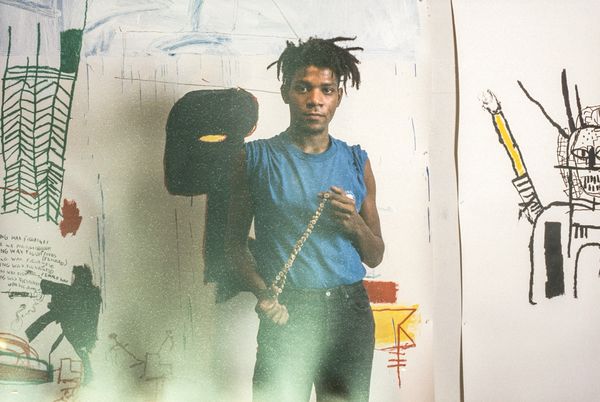Jean-Michel Basquiat in his studio. 1980s East Village Art Scene © Andreas Sterzing.
—Written by Jesse Limbacher
On view at Phillips New York through 24 March, Never Above 14th Street: A downtown NYC art show celebrates the vibrant art scene of New York City’s East Village in the 1980s and 1990s. It was during this time that an emerging group of artists rejected the uptown art circle’s intellectual focus on the limits of Minimalism and Conceptualism — instead drawn to the low rents, open spaces, and radical bohemianism of the East Village. The artistic community there thrived, led by an open-minded new generation of artists and gallery owners who saw any wall, street, or public space as an equally viable place to present art.
Below, I speak with photographer Andreas Sterzing — who documented the neighborhood as a resident in the 1980s — to better understand the unique moment of this era in the East Village. Sterzing’s photographs of this time, taken while working on assignment as a photo journalist for magazines, have been presented in several exhibitions at New York galleries as well as at the Whitney Museum of American Art, Seoul Museum of Art, and KW Berlin. His photographs have been published in Stern, Der Spiegel, Geo, Zeit Magazin, Marie-Claire, and the New York Times Magazine.

A resident walks his dogs in the East Village, surrounded by street art.
1980s East Village Art Scene © Andreas Sterzing.
Path to New York
Andreas’ interest in photography began in his teenage years. He tells me he even built a makeshift darkroom in his family’s bathroom. He eventually joined a local photography club, which led to serious photography study in Munich and early success working for German magazines. A project in California brought his ambitions stateside, and he initially intended to move to San Francisco.
“I'm curious — why San Francisco?” I ask.
“I had friends there,” he replies. “That’s when I thought it would maybe be a great city to live in, so I went back to Germany and started to plan.”
That plan was to briefly visit New York on his way to the Bay Area. However, New York quickly changed his mind.
“When I came to New York, it was November, and I had a friend living in Brooklyn who rented me a room for about $100 a month. My plan was to move to San Francisco because I heard the winters in New York could be so terrible." His outlook changed however, as Andreas remembers, “I was in New York for a week or less, and I didn’t want to go to San Francisco anymore.” He continues, “From the first moment I set foot on the ground in New York, I knew this was it.”
My original plan was to be there for maybe a year — this turned into 21 years.
—Andreas Sterzing.
Though Andreas’ photography was known to a few German magazines at the time, he had scarce contacts in New York. “But I was on the lookout for a story,” he tells me, “stories I could take to the magazines in Germany. This is how I discovered Pier 34.”
The abandoned Pier 34 in Manhattan had been turned into a communal gallery space and museum for underground art, led by artists David Wojnarowicz and Mike Bidlo. The pair invited others in their circle to join, but the space was shut down by the Port Authority as word quickly spread among East Village artists.

FUN Gallery. 1980s East Village Art Scene © Andreas Sterzing.
“What was your first impression of Pier 34?” I ask Andreas.
“It was one of those things — I walked in there and my life changed because it was very surreal. There were artists like Judy Glantzman and Rhonda Zwillinger working there. There were all these East Village artists who were all very friendly. I spoke with them and photographed them.”
It was from these artists that Andreas first heard of the scene in the East Village. He notes, “I met all these people and had heard about the East Village, but I was kind of warned. People told me, ‘Oh, it’s really dangerous to go there. There are burning buildings and criminals, and drugs.' But then I went there, and I found, this is actually a great place! People are very kind. It was all run-down buildings, but they were relatively cheap and that’s how it started.”
Andreas became friends with some of the artists and began documenting what he saw. He sent the pictures initially to German magazines who were hungry for coverage of New York. “It was really of the moment at the time,” he says. “New York was coming out of bankruptcy. The anarchy that was there — everything was completely out of control. But then there was the creativity and the artists as well.”
Though he was earning a modest living as a documentary photographer, Andreas became part of the scene, telling me, “A lot of the time I was just interested because I moved to the East Village myself. It was just a crazy time, really. It was magical.”
The Artists
Keith Haring
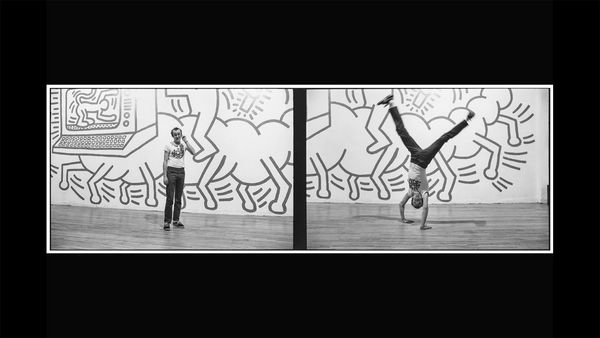
Keith Haring in a downtown gallery. 1980s East Village Art Scene © Andreas Sterzing.
“What’s the story behind this photo?” I ask Andreas.
“The thing is, Keith Haring wasn’t a friend of mine,” he says, “but I knew him, and we would say hello to each other on the street.” He goes on to say, “This photo was taken in 1983 at a gallery. I just asked him ‘Can I take some pictures of you?’ and he just did this handstand.”
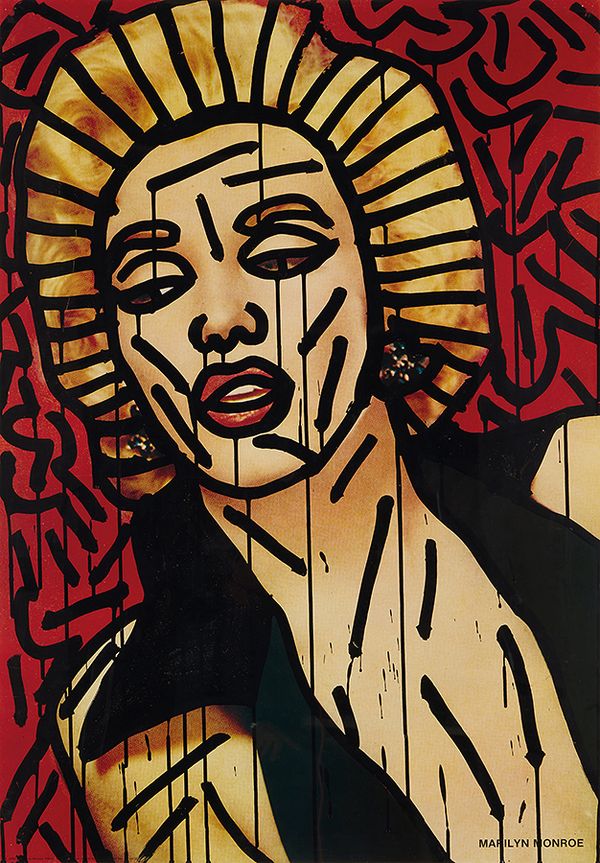
Keith Haring, Untitled (Marilyn Monroe), 1981. Never Above 14th Street.
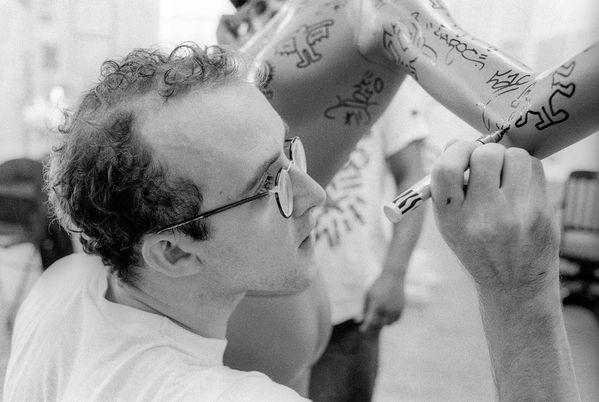
Keith Haring working in his studio. 1980s East Village Art Scene © Andreas Sterzing.
“This was for a magazine,” Andreas explains. “I think this was at his studio. We talked and I took some pictures, and it was funny.” He notes, “That’s the thing with people — when you photograph them, it’s always a collaboration. I don’t even remember what he was doing in this photo — he just drew on some model.”
Seeing this photo made Andreas chuckle a bit. “Yeah, that’s a good one,” he says. “That one’s great.”
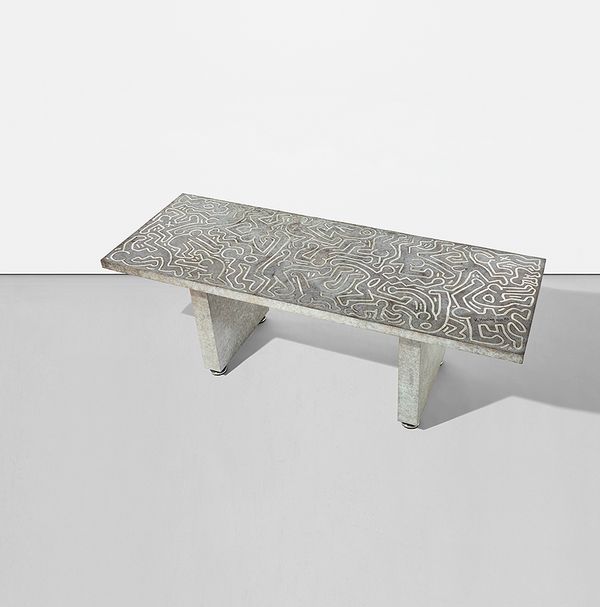
Keith Haring, Writing Table, 1990. Never Above 14th Street.
Jean-Michel Basquiat
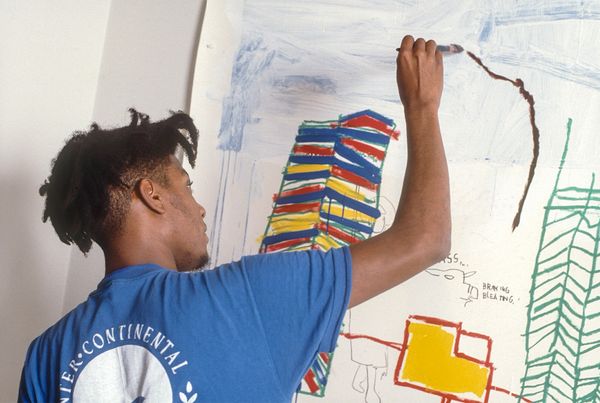
Jean-Michel Basquiat in his studio. 1980s East Village Art Scene © Andreas Sterzing.
Andreas remembers this day well, noting, "This was an assignment, as I didn’t personally know Jean-Michel Basquiat.” He continues, “He was already a superstar at the time, so he was always traveling. This was at his studio on Great Jones Street — I think it was 1986.”
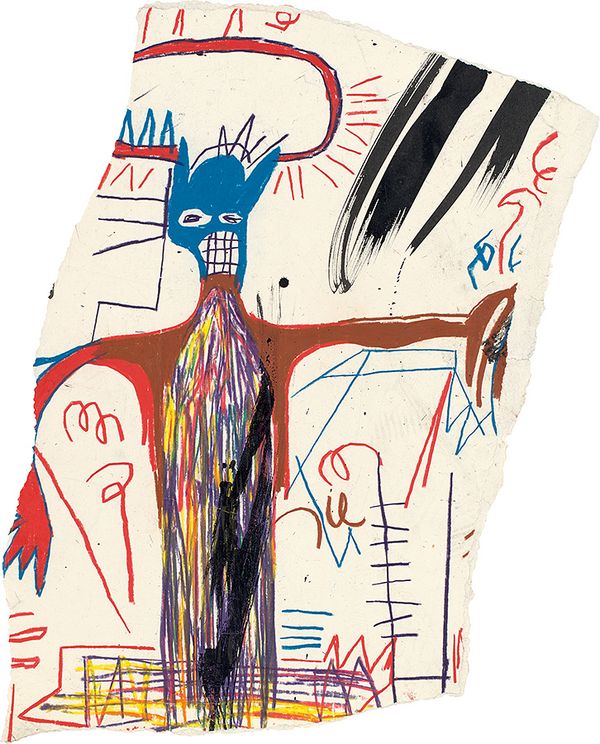
Jean-Michel Basquiat, Untitled (Figure with Blue Head), 1983. Never Above 14th Street.

Jean-Michel Basquiat in his studio. 1980s East Village Art Scene © Andreas Sterzing.
“He was very kind,” Andreas remembers. “We got along really well, and I got a good series of portraits of him in that shoot.”
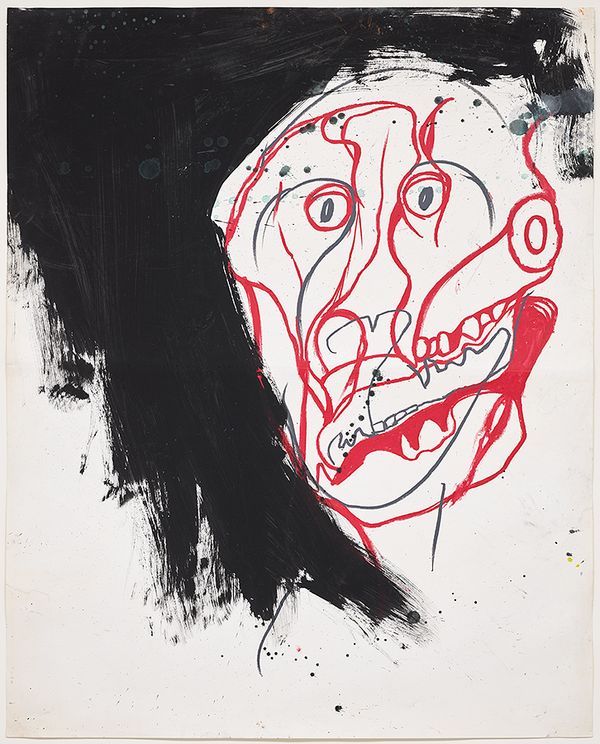
Jean-Michel Basquiat, Untitled, 1982. Never Above 14th Street.
David Wojnarowicz

David Wojnarowicz (as Lou Reed) with Dean Savard and Alan Barrows at Mike Bidlo’s "Not Warhol’s Factory" at P.S.1, 1985. 1980s East Village Art Scene © Andreas Sterzing.
David Wojnarowicz was a frequent subject of Andreas’ photographs during this time. I ask him if they were close.
“David became a good friend, really,” Andreas tells me. “We collaborated a few times and I visited him in 1989 when he already knew he had AIDS. I would visit his studio often and I took portraits of him.”
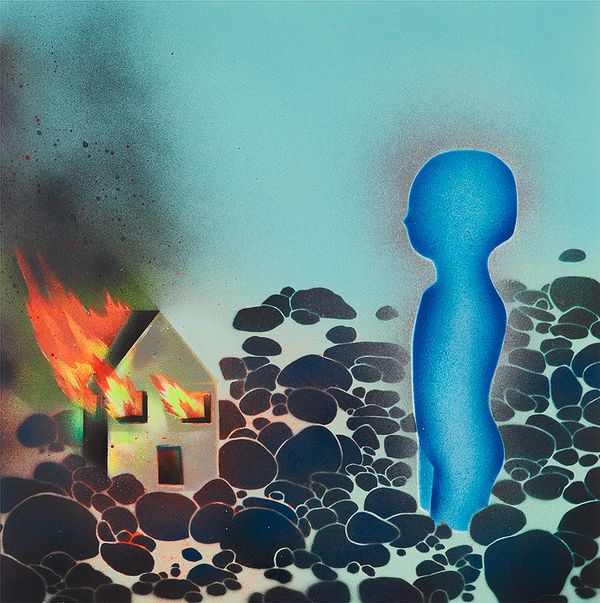
David Wojnarowicz, Burning House / Blue Figure, 1982. Never Above 14th Street.

David Wojnarowicz in his studio. 1980s East Village Art Scene © Andreas Sterzing.
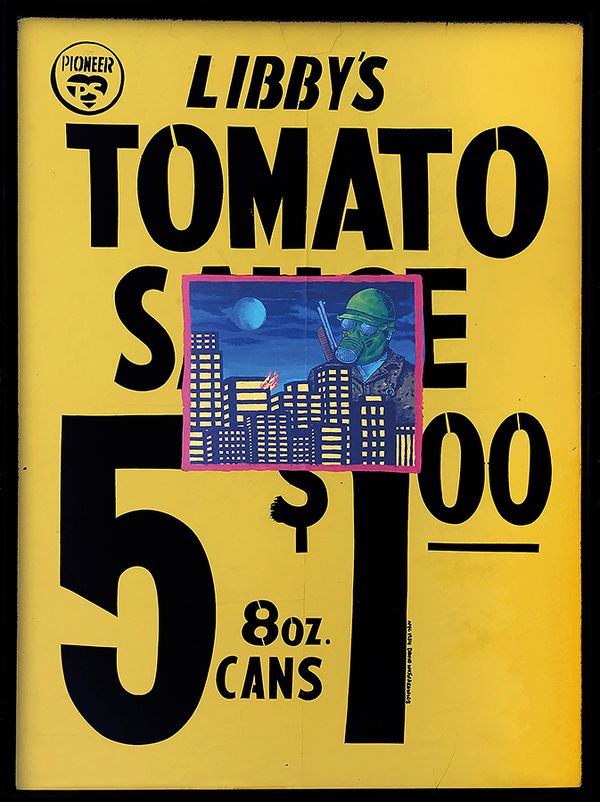
David Wojnarowicz, Tomato Sauce, 1984. Never Above 14th Street.
Mike Bidlo

David Wojnarowicz and Mike Bidlo sit beneath a collaborative work. 1980s East Village Art Scene © Andreas Sterzing.
“What’s going on in this photograph?” I inquire. “Where was it taken and what is the work they’re seated under?”
“This was a collaborative piece,” he explains. “Mike Bidlo did the Jackson Pollock background and then David painted over it. This was in David’s studio at the Clock Tower downtown.” He elaborates, “It’s just a snapshot. We were just chatting, and I would take some pictures. We were friends, you know? We were just hanging out.”
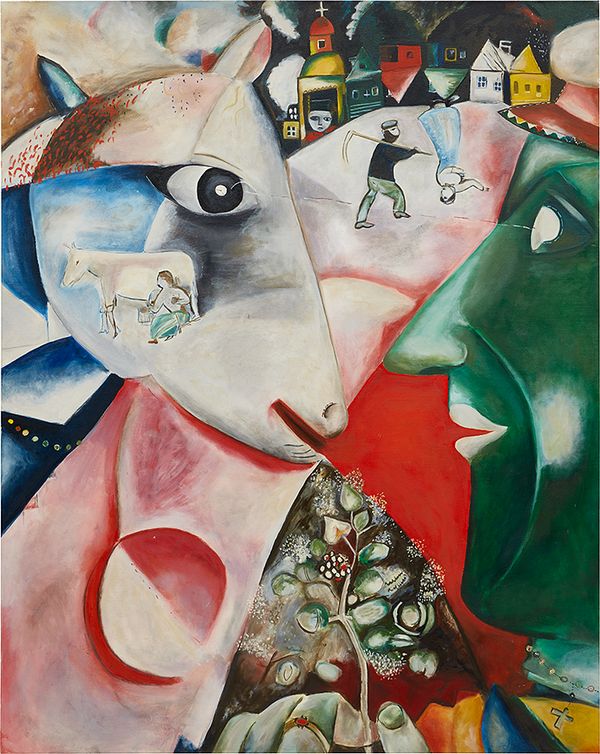
Mike Bidlo, Not Chagall, 1984. Never Above 14th Street.

Mike Bidlo, Not Warhol (Campbell’s Soup Can), 1984. Never Above 14th Street.
The Scene
Civilian Warfare Gallery
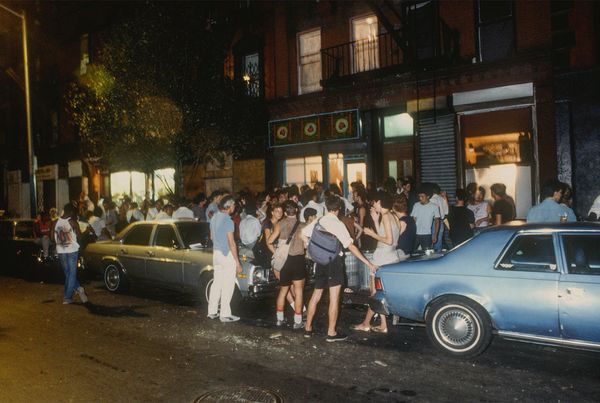
The crowd at a Civilian Warfare opening. 1980s East Village Art Scene © Andreas Sterzing.
“I’m not sure which opening this was,” Andreas says of this photograph. “It might have been the David Wojnarowicz opening, but I’m not sure.” He continues, “You can feel the heat of the summer — it’s a hot summer night and everybody is having a good time and it’s buzzing.”
Andreas was a neighbor to the gallery space, telling me, “This is on 11th Street. My apartment was just to the right.” He explains, “It was my first proper apartment, which cost $500 a month for a half-floor in one of the smaller buildings.”
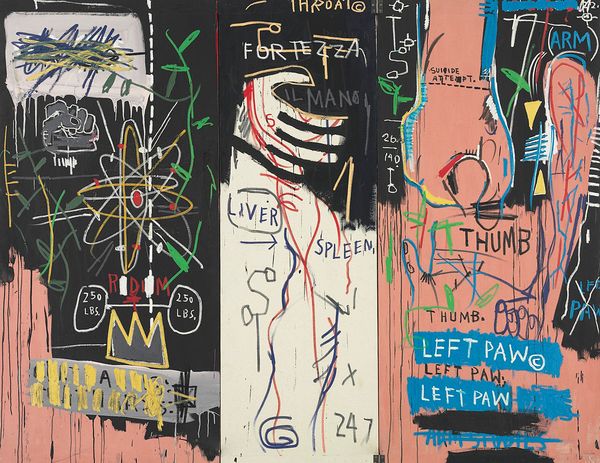
Jean-Michel Basquiat, Catharsis, 1983. Never Above 14th Street.
Gracie Mansion Gallery
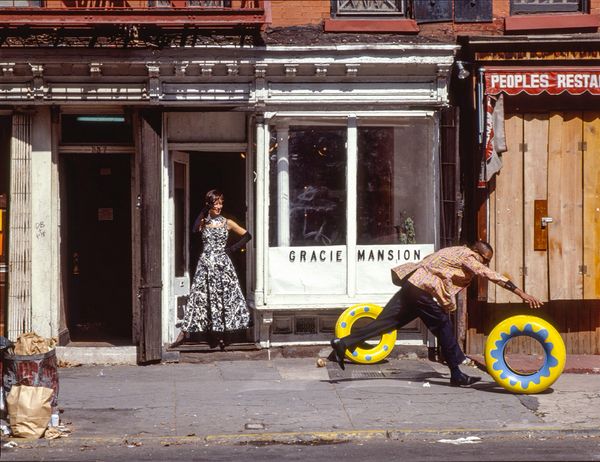
Gracie Mansion and the artist Sur Rodney Sur. 1980s East Village Art Scene © Andreas Sterzing.
“This photograph is quite fun,” I say. “Was it staged?”
“Yes, this was for a Swiss art magazine that did a story on the East Village,” Andreas replies. “I knew Gracie already at the time — we were friends. She dressed up in this Mike Bidlo Jackson Pollock dress, and the necklace she’s wearing I believe is a Rhonda Zwillinger piece,” he explains.
“We just played around," he says. "There were these strange wheels outside, these tires that somebody had popped all over the neighborhood.” He continues, “The picture just came out of that playfulness, really.”
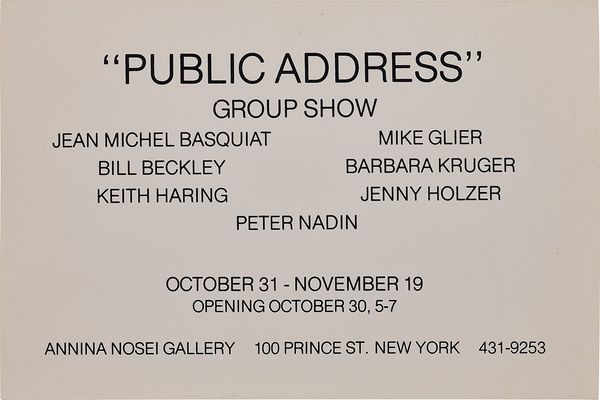
Various, Public Address group show at Annina Nosei Gallery 1982 invitation card, 1982. Never Above 14th Street.
Nature Morte Gallery
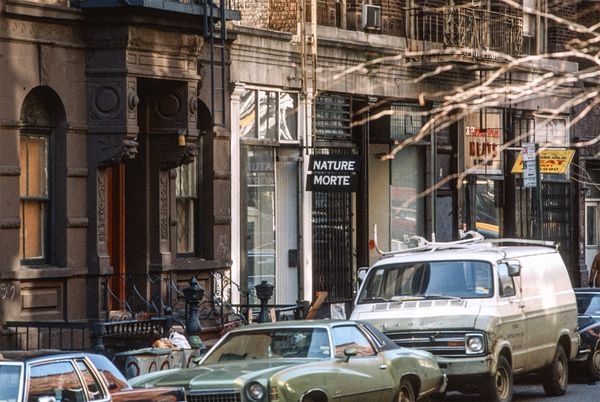
Nature Morte Gallery seen from the street. 1980s East Village Art Scene © Andreas Sterzing.
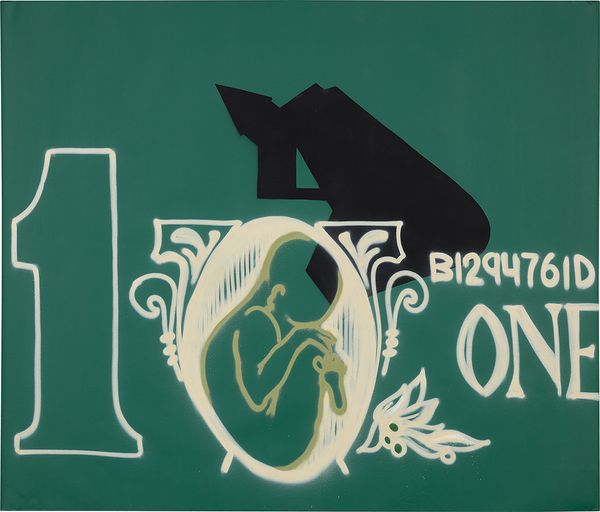
Dondi White, Untitled, 1992. Never Above 14th Street.
Club 8BC
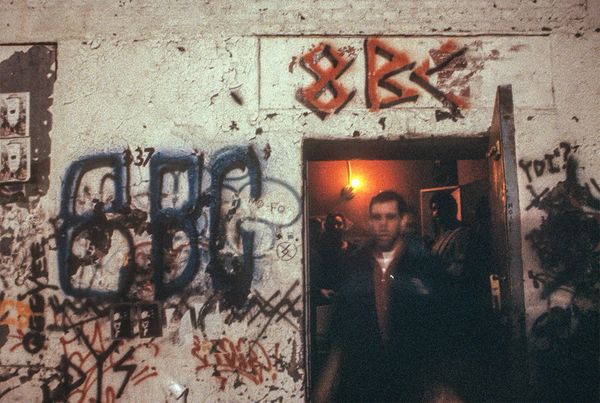
The door to club 8BC. 1980s East Village Art Scene © Andreas Sterzing.
“We were all for the nightlife,” Andreas remembers. “People went to clubs — Danceteria, Club 57, Pyramid Club, and so on,” he explains. “But I was more involved with the crowd from 8BC, which was a performance club on 8th between B and C.”

Poppo and Go-Go Boys performing at 8BC. 1980s East Village Art Scene © Andreas Sterzing.
“Do you remember this performance?” I ask.
“This performer was named Poppo,” Andreas notes. “What they did at 8BC was they took out a level. So, you would go down these stairs, but when you got to the bottom there was no floor. It was just dirt.”
He continues, “It was really crazy! There was a stage in the back and a bar up front. They had very loud music most of the time.”
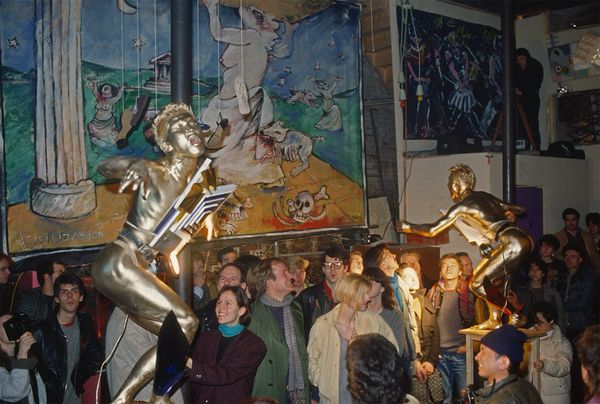
Poppo and Go-Go Boys performing at 8BC. 1980s East Village Art Scene © Andreas Sterzing.
“I photographed Poppo’s dance troupe for magazines, and one of them captioned the photo ‘Go-go boys at Club 8BC,’ which I thought was a bit odd, as these were serious dancers,” he explains. “When I showed it to Poppo he said ‘Oh! Go-go boys!’ and then after that he called the group Poppo and Go-Go Boys.”

Poppo performing with David Finn sculpture. 1980s East Village Art Scene © Andreas Sterzing.
“This was a different performance,” Andreas remembers. “Sometimes they would do things outside in the summer. The man sitting there is the artist David Finn, who I met at the Pier and became friends with.” He continues, “There was a crossover of these different artists who were collaborating with each other and I just documented it all.”
The Block
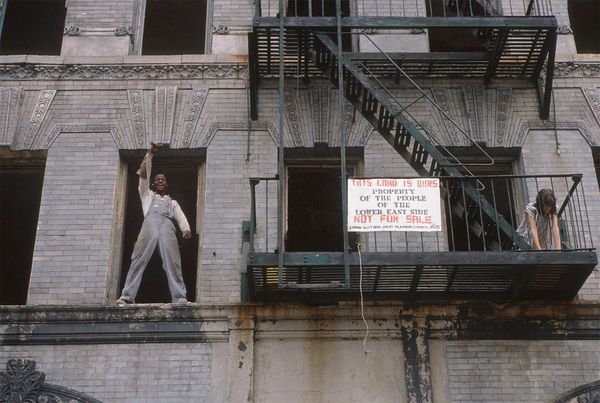
"Property of the People of the Lower East Side." 1980s East Village Art Scene © Andreas Sterzing.
“When the neighborhood started to change, there was resistance against it,” Andreas tells me. “There were these various organizations founded to protect the neighborhood and the resident’s rights.”
“Did you know these people?” I ask.
“They must have just seen me with the camera," he replies. "Perhaps I knew some of the people who lived in the building but when this man saw my camera, he posed for me.”
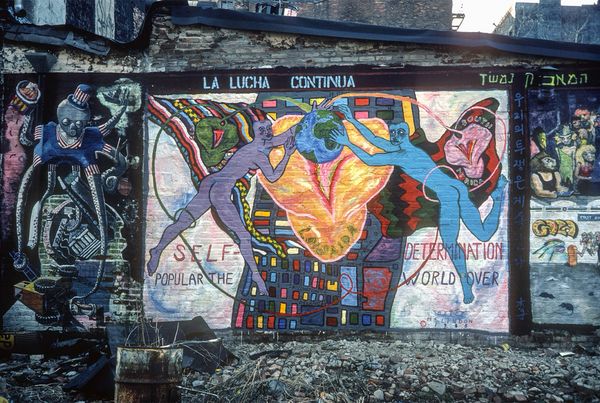
Lower East Side street art. 1980s East Village Art Scene © Andreas Sterzing.
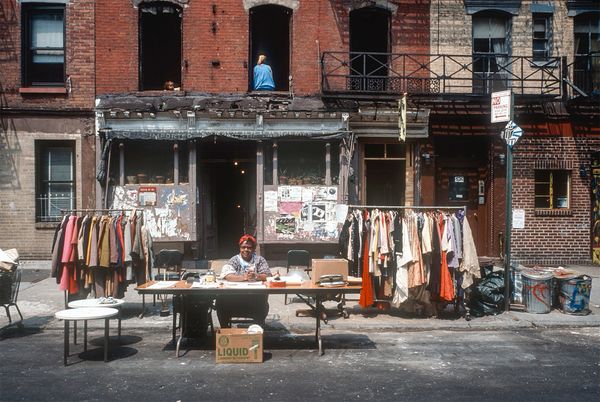
A Lower East Side street merchant. 1980s East Village Art Scene © Andreas Sterzing.
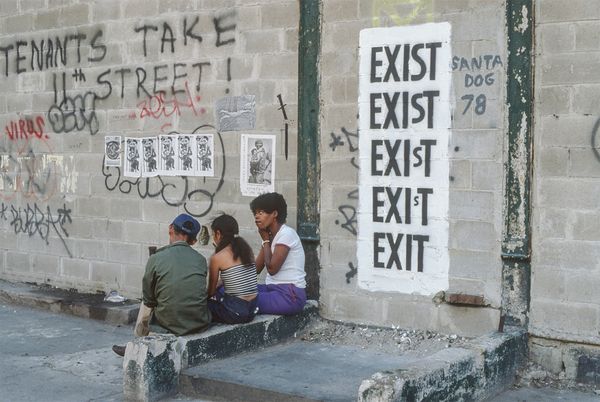
"Exist – Exit" stencil by Robert William Petrick. 1980s East Village Art Scene © Andreas Sterzing.
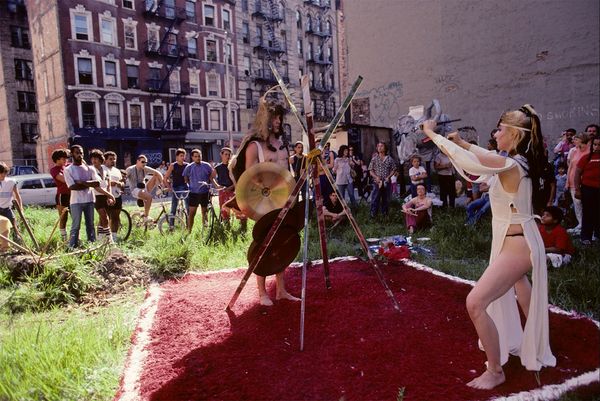
A public performance in a vacant lot. 1980s East Village Art Scene © Andreas Sterzing.
“This is where I lived and that’s just what I saw,” he explains. “There was an empty lot across the street and all kinds of things happened there.” He remembers, “There was a drug building right next to it on the left — I think it was the largest drug operation in New York City at the time.”
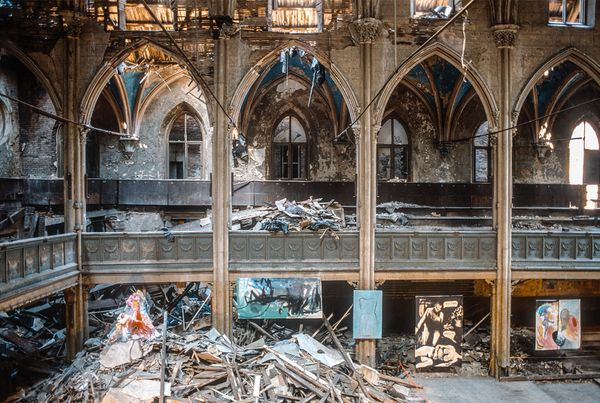
The Angel Orensanz Center. 1980s East Village Art Scene © Andreas Sterzing.
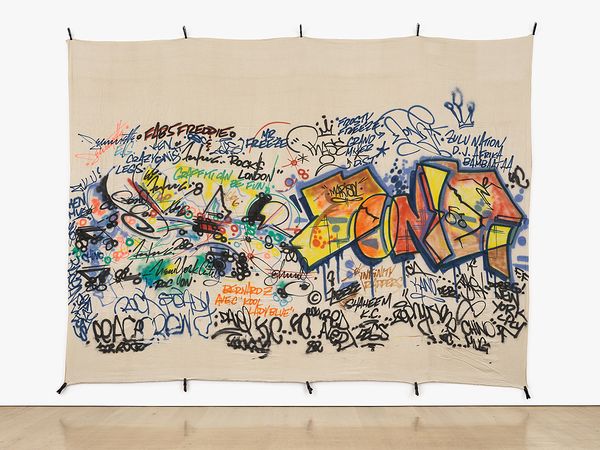
Futura 2000, Untitled, 1982. Never Above 14th Street.
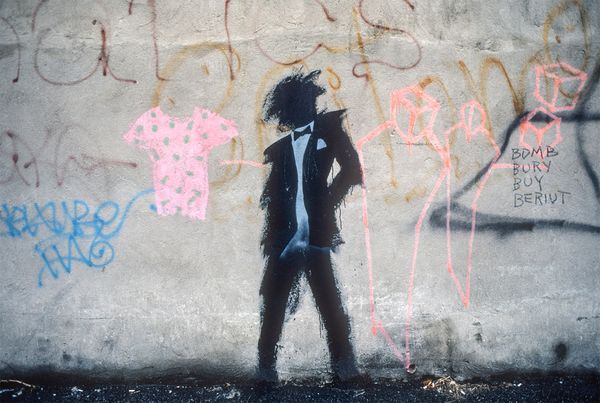
A Richard Hambleton shadow figure and other street art. 1980s East Village Art Scene © Andreas Sterzing.
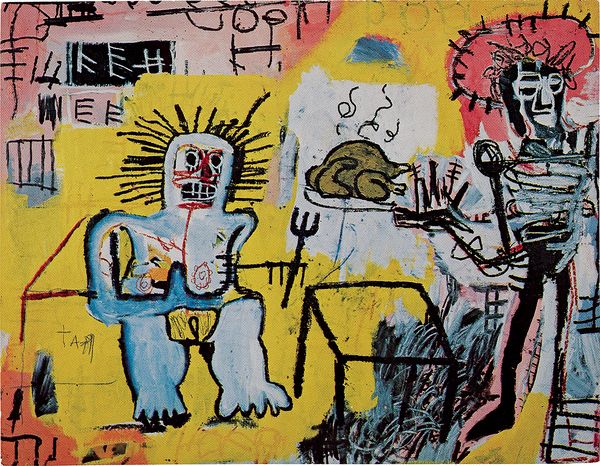
Various, Basquiat at Annina Nosei Gallery 1982 announcement card, 1982. Never Above 14th Street.

Richard Hambleton’s shadow figures. 1980s East Village Art Scene © Andreas Sterzing.
The Legacy

1980s East Village Art Scene © Andreas Sterzing.
“What do you think made this moment possible?” I ask Andreas.
“You know, at this time there was an incredible sense of freedom,” he explains. “There wasn’t huge pressure to gain notoriety — the social media thing didn’t exist yet,” he says. “If you think about something like the Pier — that spread just by word of mouth. Nowadays it would only last a week before it would be overrun with people. Things are just much faster today.”
I ask him, “At the time, did you have any sense of what this era would become? Did you consider how it would be remembered?”
“Now it’s being recognized, but for what?” he challenges. “At the time we were just experimenting and doing things. I just happened to be there and to discover what the community happened to become,” he explains. “Everyone was part of the whole thing in their own way and then the AIDS pandemic began spreading through New York and its creative community — resulting in devasting and terrible loss.”
He continues, “It was just something we were doing, without thinking much about what it would all mean, or what it would become. But at the same time, it had a profound impact on us.” He tells me, “It was just something that really exploded — an incredible creativity that emerged out of our human uniqueness.”
“We lived in the moment at that time,” he remembers. “We're lucky it happened the way it did.”
Exhibition /
PhillipsX
Never Above 14th Street — A downtown NYC art show
On View 8 March – 24 March
432 Park Avenue, New York, 10022 (map)
Learn More >
Recommended
Never Above 14th Street | The Playlist >
Alphabet City & the East Village Art Scene NYC 1980s | Video by Andreas Sterzing >
